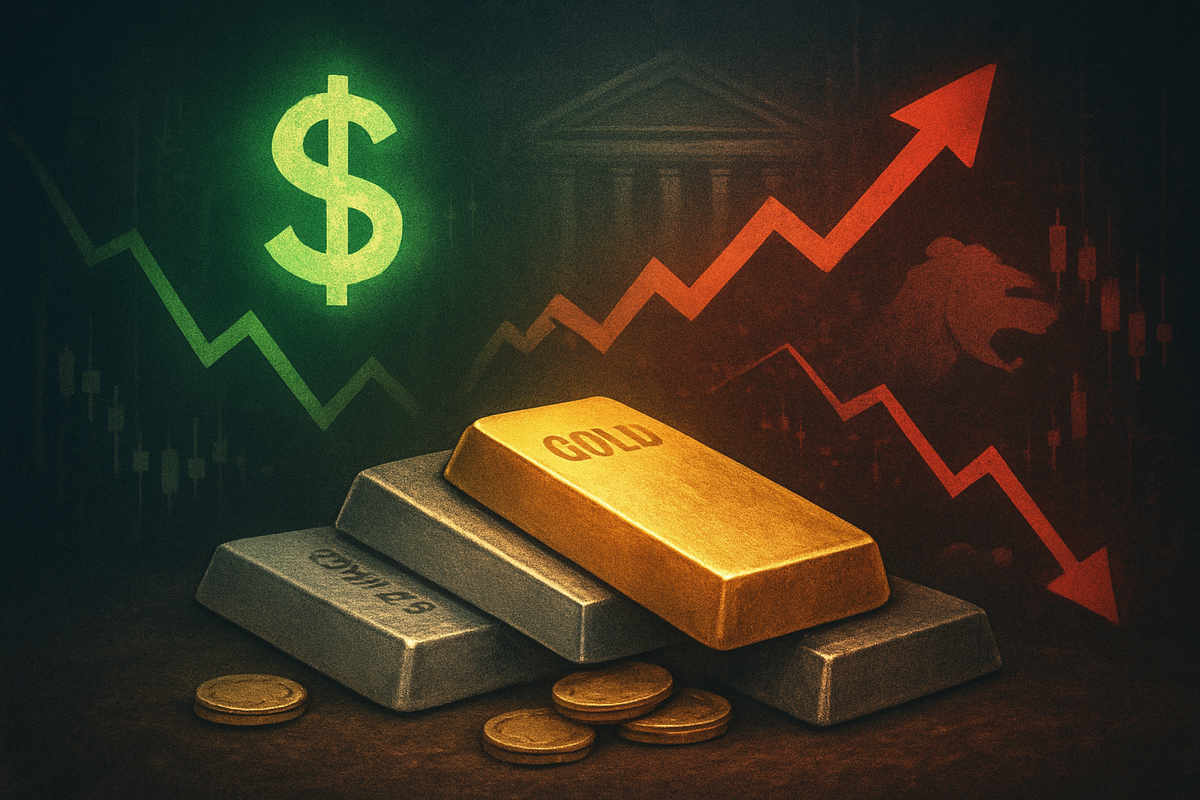
As of November 4, 2025, the global financial markets are witnessing a significant shift, with a rallying US dollar and a retreating stock market exerting considerable downward pressure on gold and silver prices. This confluence of macroeconomic factors, primarily driven by a hawkish outlook on interest rates, is creating a challenging environment for precious metals, traditionally viewed as safe-haven assets. Investors are closely monitoring the Federal Reserve's stance, as the perceived less likelihood of a potential rate cut in December and a cautious approach to further easing are making interest-bearing assets more attractive, thereby diminishing the appeal of non-yielding gold and silver.
The immediate implication of these trends is a reinforced downward pressure on gold and silver. Despite a widespread retreat in equity markets—a scenario that would typically trigger a flight to safety—the robust US dollar and the prevailing interest rate expectations are currently overriding this traditional safe-haven demand. This dynamic explains why gold is slumping even as major stock indices falter, highlighting a complex interplay of forces dictating asset valuations in the current economic climate.
The Unfolding Market Dynamics: Dollar Ascendant, Equities Descending, and Gold's Retreat
The financial landscape on November 4, 2025, is characterized by a strong US dollar, a widespread sell-off in global equities, and a noticeable slump in the prices of both gold and silver. The US Dollar Index (DXY), a measure of the dollar's strength against a basket of major currencies, has demonstrated an impressive upward trajectory, reaching 100.2058, marking a 0.33% increase from the previous session and a significant 2.14% strengthening over the past month. This surge has pushed the DXY to its highest intraday level since early August, reflecting a robust demand for the greenback amidst global uncertainties and interest rate speculation.
Concurrently, equity markets worldwide are experiencing a notable retreat. In India, benchmark indices such as the Sensex and Nifty50 saw declines of 0.62% and 0.64% respectively. US stock futures indicated a sharp decline, with S&P 500 futures down 1.1% and Nasdaq 100 futures down 1.4%. The previous trading day saw the S&P 500 (NYSEARCA: SPY), Nasdaq (NASDAQ: QQQ), and Dow Jones Industrial Average (NYSEARCA: DIA) finishing down 1.2%, 2%, and 0.5% respectively. This broad-based equity weakness suggests investor apprehension regarding economic growth prospects and corporate earnings.
Against this backdrop, precious metals have not been able to leverage their traditional safe-haven status. Gold prices dropped on November 4, 2025, with MCX Gold December futures in India falling 0.43% to ₹1,20,886 per 10 grams. Globally, Comex gold futures traded lower, slipping by $19.19 (0.48%) to $3,994.81 per ounce, while the spot price declined to $3,935.28 per troy ounce. Silver has followed a similar path, falling to $47.13 per troy ounce, down 2.00% from the previous day and 2.95% over the past month, with MCX Silver December contracts also dropping 0.41% to ₹1,47,154 per kg. Silver prices are currently consolidating around $47.50 after a recent correction from a peak of $50.
The primary catalyst for these market movements appears to be the evolving outlook on interest rates, with the Federal Reserve (Fed) at the center of attention. Traders are "mulling rate outlook," with a perceived "less likelihood of a potential rate cut in December" and a cautious stance from the Fed regarding further easing. This diminishing expectation of rate cuts significantly impacts gold and silver, as these non-yielding assets become less attractive compared to interest-bearing alternatives when rates are high or expected to remain so. Key players involved include central banks, particularly the Federal Reserve, major financial institutions, and global investors reacting to monetary policy signals and economic data. The timeline leading up to this moment has been characterized by persistent inflation concerns, central bank hawkishness, and a gradual reassessment of the timing and pace of potential rate adjustments, culminating in the current market sentiment of a stronger dollar and weaker risk assets.
Corporate Fortunes: Winners and Losers in a Shifting Economic Tide
The current macroeconomic environment, characterized by a rallying US dollar, a retreating stock market, and slumping gold and silver prices, is creating a distinct divide between potential winners and losers among public companies. This intricate interplay of forces impacts various sectors differently, with particular implications for multinational corporations, investment firms, and the precious metals mining industry.
US-based multinational corporations with significant international revenue streams are facing considerable headwinds. Companies like Coca-Cola (NYSE: KO), PepsiCo (NASDAQ: PEP), Procter & Gamble (NYSE: PG), Pfizer (NYSE: PFE), Apple (NASDAQ: AAPL), and Microsoft (NASDAQ: MSFT), which derive substantial portions of their sales from overseas, see their foreign earnings diminish when converted back into a stronger US dollar. This directly impacts their reported revenues and profitability. Furthermore, a stronger dollar makes US exports more expensive, potentially reducing demand for their products abroad and eroding market share. Conversely, foreign companies with substantial sales in the US market stand to benefit, as their dollar-denominated income translates into greater value when converted to their local currencies. Similarly, US companies that heavily import raw materials or finished goods, such as Walmart (NYSE: WMT), Dollar General (NYSE: DG), and Costco (NASDAQ: COST), could experience reduced input costs, potentially boosting their profit margins.
The retreating stock market presents a challenging landscape for almost all public companies, but particularly for those with high growth expectations, significant debt, or reliance on capital markets for expansion. Growth-oriented technology companies, often with elevated valuations, are especially vulnerable as investors shift towards less risky assets. Investment firms are also directly impacted, facing reduced Assets Under Management (AUM) as stock valuations decline, leading to lower management fees. Performance fees also suffer in a bear market, and firms may experience increased redemptions as investors withdraw funds. Companies like BlackRock (NYSE: BLK), Vanguard (private), and other major asset managers could see their revenue streams squeezed. Highly leveraged companies and those in the consumer discretionary sector are also susceptible to recessionary pressures that a declining market often signals.
For the gold and silver mining industry, the slump in precious metal prices is a direct blow. Companies such as Newmont Corporation (NYSE: NEM), Barrick Gold Corporation (NYSE: GOLD), Agnico Eagle Mines Limited (NYSE: AEM), and silver miners like Pan American Silver Corp. (NASDAQ: PAAS) and Endeavour Silver Corp. (NYSE: EXK) will likely experience reduced revenues and compressed profit margins from their mined output. This can lead to decreased stock valuations, potential cuts in capital expenditures, and even the closure of less efficient mines if prices remain depressed. While some mining companies, like Silvercorp Metals Inc. (NYSEAMERICAN: SVM), might have lower operating costs that offer some resilience, the overall sector faces significant headwinds. On the other hand, industries that use gold and silver as raw materials, such as jewelers like Tiffany & Co. (owned by LVMH, OTCPK: LVMUY) and manufacturers in the electronics or solar energy sectors, could benefit from lower input costs, assuming consumer or industrial demand remains robust.
Broader Implications: A Shift in Global Financial Tides
The current confluence of a rallying US dollar, a retreating stock market, and slumping gold and silver prices on November 4, 2025, is not an isolated event but rather a manifestation of broader, interconnected industry trends and global economic shifts. This scenario highlights a significant re-evaluation of risk and return in financial markets, primarily driven by central bank policies and evolving global economic sentiment.
This event fits squarely into a broader trend of monetary policy divergence and its impact on currency markets. The Federal Reserve's cautious stance on interest rate cuts, or even the perception of a delay in easing, contrasts with other central banks that might be pursuing more accommodative policies or facing greater economic headwinds. This divergence strengthens the dollar as investors flock to higher-yielding US assets, making it a preferred currency for capital allocation. For precious metals, this represents a significant challenge, as their inverse relationship with the dollar means a stronger greenback inherently makes them more expensive for international buyers, dampening demand.
The retreating stock market, even as gold slumps, indicates that the traditional safe-haven appeal of gold is being overshadowed by other factors, primarily the allure of higher real yields in dollar-denominated assets. This challenges the conventional wisdom that during equity market downturns, investors will automatically pivot to gold. Instead, it suggests a market where the opportunity cost of holding non-yielding assets is paramount. This could have ripple effects on competitors in the asset management industry, with firms that are heavily invested in precious metals or traditional safe-haven strategies potentially underperforming those with a more diversified or dollar-centric approach. Partners in the mining sector, such as equipment suppliers or service providers, could also face reduced demand as mining companies cut back on capital expenditures.
Regulatory and policy implications largely revolve around central bank communication. The market's "mulling rate outlook" underscores the critical role of the Federal Reserve's forward guidance. Any shift in this guidance, whether towards a more hawkish or dovish stance, could trigger significant market reactions. Policy makers will be closely watching inflation data, employment figures, and global economic stability to inform their decisions, which will, in turn, influence currency strength and asset prices. Historically, periods of dollar strength and rising real interest rates have often coincided with pressure on commodity prices, including gold and silver. For instance, in the early 1980s, under Paul Volcker's Fed, aggressive rate hikes led to a strong dollar and a significant decline in gold prices, despite economic uncertainty. More recently, periods of Fed tightening have similarly put pressure on precious metals, even if for shorter durations. This historical precedent reinforces the current market dynamics, where the perceived trajectory of interest rates is a dominant force.
The wider significance also extends to global trade and corporate earnings. A strong dollar can make US exports less competitive, potentially impacting the trade balance and the profitability of multinational corporations. Conversely, it can make imports cheaper, potentially helping to curb inflation but also posing challenges for domestic industries competing with lower-priced foreign goods. This complex interplay of currency, equity, and commodity markets underscores a global financial system highly sensitive to central bank rhetoric and the pursuit of yield in a volatile economic landscape.
The Road Ahead: Navigating Volatility and Unearthing Opportunities
The current financial climate, marked by a rallying US dollar, a retreating stock market, and a cautious interest rate outlook, sets a complex stage for gold and silver. While the immediate horizon presents challenges for these precious metals, a deeper look reveals both short-term volatility and long-term opportunities for astute investors and strategic companies.
In the short term, the strength of the US dollar is likely to remain a significant headwind. As of November 4, 2025, a robust dollar makes gold and silver more expensive for international buyers, dampening demand and potentially leading to continued price corrections. Easing geopolitical tensions, if they materialize, could further temper safe-haven demand. However, the retreating stock market, a classic trigger for safe-haven buying, could still provide a floor for prices. Furthermore, any shifts in the Federal Reserve's cautious stance on interest rates, particularly a move towards rate cuts, would reduce the opportunity cost of holding non-yielding assets, potentially offering a boost to gold and silver. Short-term forecasts for gold suggest moderate rises due to geopolitical turbulence and inflationary expectations, with prices potentially reaching around $4,046 to $4,230 per ounce by year-end. Silver, currently consolidating around $47.50, is also expected to see modest gains, possibly reaching $49.53 by the end of Q4 2025.
Looking further ahead, the long-term outlook for both gold and silver appears bullish. Gold is poised for a multi-year bull market, driven by ongoing monetary base expansion, persistent inflation concerns, and sustained demand from central banks, particularly those in emerging markets diversifying their reserves away from the dollar. Goldman Sachs, for instance, forecasts a 6% rise through mid-2026, reaching $4,000, while others predict $5,000 by 2026 and even $5,155 by 2030. Silver's long-term prospects are equally compelling, bolstered by its expanding industrial applications in green technologies such as photovoltaics, electronics, and electric vehicles. Analysts anticipate silver could significantly outperform gold in the next phase of the bull market, with some projections reaching $60 by mid-2026, $100 by 2030, and even $190 by 2037, especially if it decisively breaks the $50 psychological barrier.
Potential scenarios include a sustained safe-haven rally if equity markets deepen their retreat and geopolitical tensions escalate, pushing gold potentially above $5,000 and silver towards $100. Alternatively, a dollar-induced short-term correction could precede a rebound driven by fundamental demand. A scenario of cautious growth with modest gains is also possible if economic conditions stabilize and central banks maintain their cautious stance. For investors, diversification with precious metals remains crucial for hedging against inflation and market volatility. A long-term perspective, buying on dips, and monitoring key economic indicators like the DXY and Fed statements are vital. Companies in the precious metals sector, particularly miners, should focus on operational efficiency, strategic hedging, and innovation in exploration, while aligning with the growing industrial demand for silver in sustainable technologies.
Comprehensive Wrap-up: Navigating the New Normal
The current financial landscape, as of November 4, 2025, is defined by a powerful convergence of a rallying US dollar, a retreating global stock market, and a subsequent slump in gold and silver prices. The key takeaway from this event is the profound influence of monetary policy expectations, particularly the Federal Reserve's cautious stance on interest rates, which has significantly altered the traditional dynamics of safe-haven assets. The dollar's strength, fueled by the allure of higher yields in US assets, has largely overshadowed gold's conventional role as a refuge during equity market downturns, creating a challenging environment for precious metals in the immediate term.
Moving forward, the market will remain highly sensitive to central bank communications and economic data. The interplay between currency strength, equity performance, and interest rate expectations will continue to dictate asset flows. While the short-term outlook for gold and silver may be characterized by volatility and pressure from a strong dollar, their long-term fundamentals remain robust. Gold's enduring appeal as an inflation hedge and store of value, coupled with central bank demand, provides a strong foundation. Silver, benefiting from both its safe-haven characteristics and burgeoning industrial demand in green technologies, is positioned for significant long-term growth.
The lasting impact of this period could be a recalibration of investor perceptions regarding safe havens. While gold and silver retain their intrinsic value, their short-term performance is increasingly tied to relative interest rate differentials and the strength of the dollar. This "new normal" requires investors to adopt a more nuanced approach, balancing traditional safe-haven strategies with a keen awareness of macroeconomic shifts.
Investors should closely watch several key indicators in the coming months:
- Federal Reserve Policy: Any hints of a shift in the Fed's stance on interest rates, particularly towards more aggressive easing, could significantly boost precious metals.
- US Dollar Index (DXY): Continued dollar strength will likely keep pressure on gold and silver, while a weakening dollar could provide a strong tailwind.
- Inflation Data: Persistent inflationary pressures could reignite gold's appeal as an inflation hedge, even amidst a strong dollar.
- Geopolitical Developments: Escalating global tensions could increase safe-haven demand, potentially overriding other negative factors.
- Equity Market Performance: A sustained and severe stock market downturn could eventually force a stronger flight to safety into precious metals.
- Industrial Demand for Silver: Keep an eye on reports regarding solar panel installations, EV production, and other industrial applications that drive silver demand.
In conclusion, while the current market presents headwinds for gold and silver, their fundamental roles in a diversified portfolio and their long-term growth drivers remain intact. The present moment calls for strategic patience and a vigilant eye on the evolving macroeconomic landscape, as opportunities are likely to emerge from this period of transition.
This content is intended for informational purposes only and is not financial advice





